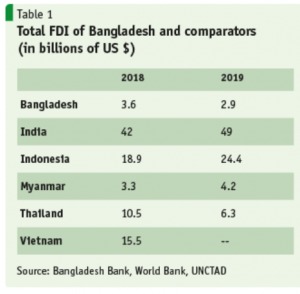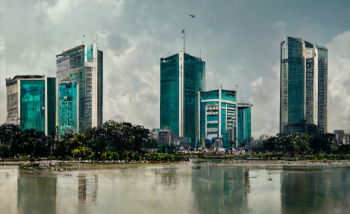Written by: Reshma Haque and Rassiq Aziz Kabir
Introduction
In the current global framework, foreign direct investment (FDI) is a powerful tool to promote economic growth. The transfer of technology and managerial know-how enables a capital-poor nation to increase physical capital, create employment opportunities, develop productive capacity, improve local labor skills, and assist in integrating the national economy with the global economy. For a country like Bangladesh which is vying to become a middle-income country and is seeking sustainable economic growth, FDI is all the more important. As a result, there has to be an effective strategy for major institutional reforms, drastically lower levels of control, a greater supply of necessary infrastructure, and an improved environment for investment to attract FDI in Bangladesh.
Present Situation of FDI in Bangladesh
According to the Bangladesh-United States Department of State (2021), Bangladesh received $16.9 billion in foreign direct investment (FDI) in 2019, with the United States being the largest investor, having $3.5 billion in total investments. In 2019, FDI into Bangladesh totaled $1.6 billion. The FDI inflow rate in Bangladesh in that year was one of the lowest in Asia and was 0.53 percent of the country’s GDP. According to UNCTAD’s World Investment Report, the situation hasn’t significantly changed even in the past few years.

Development of Trade and Investment Relations
Bangladesh may attract FDI by strengthening its trade and investment relations with Asian countries. Bilateral trade is a positive indicator of investment, trade, and value chain integration. Bangladesh is noticeably absent from the trade in intermediate goods that is led by nations with strong connections to the Asian value chain, and FDI may play a significant role in this sector. It is important to highlight that Bangladesh attracts the most foreign direct investment from the nations with which it has strong bilateral trade relations. The country has good diplomatic and economic relations with wealthy western nations and sells a large number of goods to the US, UK, and EU markets. Exporters from Bangladesh must also concentrate on establishing deeper commercial ties with Asian economic powerhouses and economic blocks. According to Mansur, by 2025, the total size of these markets will be comparable to that of the EU and the USA, making it much less prudent to ignore them as it won’t be wise to heavily rely on the western economies, which are experiencing slowing trends at present (2020).
Promotion of RMG Backward Linkage
To sustain the extensive RMG industrial base, Bangladesh’s RMG sector needs backward linkage industries in sectors like spinning and textiles, chemicals utilized in RMG industries, and replacement components. One such opportunity is a woven fabric, which now accounts for 60–65 percent of the RMG sector’s potential. Each year, imports of synthetic yarn and fabric total several billion dollars, making this backward-linkage RMG industry a prime candidate for FDI. Used spare parts and textile chemicals are imported for use in Bangladesh’s RMG sector, which is anticipated to reach $1.38 billion by the Fiscal Year 2024 (Mansur, 2020). By investing in the recycling of used clothing and leftovers, Bangladesh may also attract FDI through the RMG industry and preserve its level of accessibility to the EU market.
Special Economic Zones
One of the principal ways through which we can attract FDI is through the smooth operation of special economic zones. There has been approved to establish as many as 97 economic zones throughout the country, of which 68 are government and 29 are private economic zones (Economic Zones Site & laquo; BEZA, n.d.). The establishment of these many economic zones in the country is very much in line with the vision 2041 of the Bangladesh Government, which is to transform Bangladesh into a developed country by the year 2041 ((Express, n.d.). The economic zones are estimated to create 10 million new jobs and earn foreign currency worth $40 billion within the next 15 years ((Express, n.d.). Although they might be instrumental in bringing foreign direct investment to the country, special attention should be paid so that there is sound infrastructure and no supply-side constraints.
Reduction of Tariff Rates
Although Bangladesh has gradually reduced tariffs ever since it got more and more integrated with the international trading community, starting from being a part of the World Trade Organization in the 90s, along with the gradual deviance from import-substituting industrialization to a more open economy, tariff rates came down exponentially in the last decade. According to Mansur, although there is still room for improvement, as of 2020, the average nominal protection (the percentage of tariff imposed) in Bangladesh is 26.75%, which is still very high as per global standards (2020). This acts as a huge barrier to attracting FDI from the perspective of Bangladesh.
Through Demographic Dividend
Bangladesh has a huge advantage compared to many other countries in the world when it comes to the working-age population. Since 2007, more than 65% of the population of Bangladesh is between the ages of 15 and 64 (Abusaleh, 2017). Bangladesh can benefit from this figure by industrializing and establishing businesses, which may make attracting foreign direct investment easier. Bangladesh will not enjoy this advantage for long as the country is not experiencing galloping population growth like it did this decade.
Geographical Location and Other Factors
Bangladesh, geographically, is in a very strategic location, which can translate into creating a few industries that would be analogous to the geopolitical specifications for this reason. This might be a significant way of attracting foreign direct investment into the country. Also, through the improvement of the overall private and public infrastructure as well as the mitigation of corruption, FDI can be attracted to Bangladesh.
Conclusion
Bangladesh, although one of the fastest developing countries in the world, has one of the poorest shares of FDI in the overall GDP of the country. As of the data of 2020, it is only 0.4% of our GDP, which is not up to the mark even by the standards of the least developed countries (Foreign Direct Investment, Net Inflows (% of GDP)-Bangladesh | Data, n.d.). FDI is one of the principal economic indicators of a country’s economic well-being. Hence, it is absolutely necessary for Bangladesh to take measures that might in turn increase foreign direct investment.
Featured Image Courtesy: Generated by AI Tool
References
- Abusaleh K. (2017). Demographic Dividend in Bangladesh: Quest for Initiatives. Retrieved from https://www.researchgate.net/publication/327837831_Demographic_Dividend_in_Bangladesh_Quest_for_Initiatives/citations#fullTextFileContent
- Bangladesh – United States Department of State. (2021, July 19). United States Department of State; www.state.gov. https://www.state.gov/reports/2021-investment-climate-statements/bangladesh/#:~:text=Bangladesh’s%20Foreign%20Direct%20Investment%20(FDI,lowest%20of%20rates%20in%20Asia.
- Economic Zones Site « BEZA. (n.d.). Economic Zones Site « BEZA; www.beza.gov.bd. Retrieved August 25, 2022, from https://www.beza.gov.bd/economic-zones-site/?fbclid=IwAR09ZnzXI4cb-4sBfSpAIE6QNHcTJNpBjaMGfJ5OF08jp_d2LvHpVSQttY0
- Express, T. F. (n.d.). A recipe for a developed country. The Financial Express; thefinancialexpress.com.bd. Retrieved August 25, 2022, from https://thefinancialexpress.com.bd/views/analysis/a-recipe-for-a-developed-country-1617387292
- Express, T. F. (n.d.). Growth potential of economic zones. The Financial Express; thefinancialexpress.com.bd. Retrieved August 25, 2022, from https://thefinancialexpress.com.bd/editorial/growth-potential-of-economic-zones-1649435125
- Foreign direct investment, net inflows (% of GDP) – Bangladesh | Data. (n.d.). Foreign Direct Investment, Net Inflows (% of GDP) – Bangladesh | Data; data.worldbank.org. Retrieved August 25, 2022, from https://data.worldbank.org/indicator/BX.KLT.DINV.WD.GD.ZS?locations=BD&fbclid=IwAR1oFcsPcwZ3wKxA3aC8Hvo8f_Xzr531GP_Lo2ogjJF15O_4M-F4-dSRBD0
- Mansur, A. H. (2020, October 25). Strategy for attracting FDI in Bangladesh – Should we look East? – Policy Insights. Strategy for Attracting FDI in Bangladesh – Should We Look East? – Policy Insights; policyinsightsonline.com. https://policyinsightsonline.com/2020/10/strategy-for-attracting-fdi-in-bangladesh-should-we-look-east/
